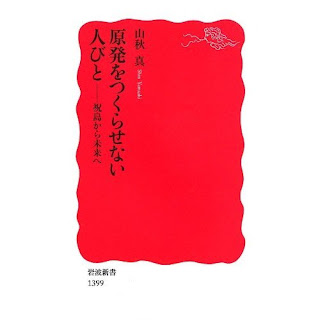February
2nd, 2013
There ARE “People Who Will Not Let
Nuclear Plants Be Built”
I’m writing book reviews for Kumamoto
Nichinichi Shimbun (Kumamoto Daily News). This time I’m introducing a new
book by Shin Yamaaki, who is the chief of W-WAN, a subgroup of WAN, and also a
planning member of the Nuclear Free Now conference held in Tokyo and Koriyama
at the end of 2012. At the conference she co-organized the “Make Your Everyday
Ambiguous Dissatisfaction into Political Issues” project with Greenpeace.
“People Who Will Not Let Nuclear Plants Be
Built
--- From
Iwaishima To the Future ---“
Written by
Shin Yamaaki
(Iwanami
Shoten, 21/12/2012)
Book Review: “People Who Will Not Let Nuclear Plants Be Built”
30 Years since the Building Plan --- A Document of Resistance of Iwaishima
I knew that there were 54 nuclear plants
in Japan. Since the first plant was built in Tokaimura village, Japan’s nuclear
plants have increased at a pace of two plants a year, but their actual building
sites are limited to the 17 places that were chosen in the 1970s. In the other
30 places which the authorities picked out as potential locations after that
period, no nuclear plants have ever been built. The reason is because the local
people resisted and held out. This is what I learned from reading this book. I
also learned why there are places like Fukushima and Tsuruga, where a string of
plants are located and therefore called “Genpatsu [=Nuke] Ginza,” and how the
government’s grant system works -- one more plant means one more pile of subsidy
money and the locals tend to get addicted to it. All these revelations opened
my eyes to the reality.
The author Yamaaki is a freelance writer, who wrote
the book “A Test of Local Autonomy -- 13 Years in a Proxy War Against Nuclear
Power for the Citizens of Suzu City, Noto Peninsula,” (Katsura Shobo) [Buy this book: jump to an Amazon page]
In this book Yamaaki closely covers the protest campaigns of the Suzu citizens
who refused to allow the building of a nuclear power plant. She was awarded the
Matsui Yayori Journalist Award and the Arai Namiko Award for the book.
On
Noto Peninsula there is a nuclear plant in Shika Town, but not in Suzu City. On
Kii Peninsula, Japan’s largest peninsula, which is located centrally, there are
none. This is because people there refused to accept the plant building plans
in Wakayama and Mie Prefectures. You can read the details in the book “A Record of the Continued Refusal of
Wakayama to Allow a Nuclear Power Plant” (Jurousha). [Buy this book: jump to an Amazon page] There sure were people who chose not to live
with nuclear plants. Can we claim innocence for ourselves just by saying, “We
were tricked,” or, “We believed in the state”?
Yamaaki’s
latest book consists of reports from the island of Iwaishima, which had been
the biggest nuclear issue up until 3/11, the Great East Japan Earthquake. This
book documents 30 years of resistance since a plan emerged to build a nuclear
plant in Tanoura of Kaminoseki Town located on the opposite shore, just 4
kilometers from Iwaishima. Instinct told the islanders that there must be
something behind it, when the authorities say, "We’ll give you money to let us build a
plant." And they were right. Yamaaki quotes the words of the late Masahiro
Tachibana, a Buddhist monk in Tsuruga City, who said “Five, or perhaps 10 more
years of resistance will force the plant plan to financial ruin. Hold on 10
more years.” Yes, there was financial ruin, but at too big a cost with the
Fukushima disaster.
Yamaaki
vividly presents the voices of the men and women of Iwaishima in her chronological
document. The most powerful were those of the obachan [=elderly women]. They said, “We put men aside. Women are
stronger --- that was what we noticed once we started [the campaign].” The
battle against nuclear plants is one against money. In the process of all those
conciliatory
approaches by Chugoku Electric Power, Iwaishima Fisheries Cooperative Association
refused to take the compensation of 1.1 billion yen for fisheries, the kind of money which
the other fishery associations accepted. What helped them stick to their
position to the end was also the power of the obachan, who said “Anybody who’s got money won’t be able to speak
freely.“ When you accept the money, you are selling out the sea. A fisherman
said, “The sea doesn’t belong to somebody. This is everybody’s sea. So all of
us have to protect it.”
Chugoku
Electric Power got the ball rolling in the name of research in 2005, and
“began” landfill works in 2009. The situation became tense, and signaled the
beginning of the battle on the land and at sea. Sit-in demonstrations, protests
by fishing boats, actions by kayak troops, and so on. What happened in February
2011 was almost a naval combat. Yamaaki’s skillful pen reports the scenes as if
it were exciting live coverage. Even during the dangerous sea campaign there
were no casualties, probably thanks to the locals’ masterly seamanship, which
has been a tradition of the islanders since the Middle Ages. The Iwaishima
islanders are a proud people who do not take orders.
The
once suspended plan of the Kaminoseki plants, due to the Fukushima accident, is
now in an unpredictable situation following the change of administration. How
huge a price does this country need to pay to learn its lesson?
---------------------------------------------------------------------
(appeared
first in Kumamoto Nichinichi Shimbun, January
6, 2013)
Translated
by A. Tawara

No comments:
Post a Comment